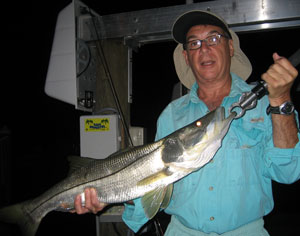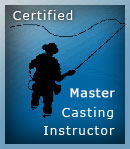Flies for Snook
What natural baits do snook prefer? They will eat smaller fish, shrimp and crabs. Baitfish, when available, comprises the largest part of their diet during most of the year. As this is being written, small baitfish, that have recently hatched, are most common in shallow water. These “glass minnows” must taste like candy to a snook and other predators because they seem to relish their flavor. When large quantities of bait are available, predators like snook can afford to be selective and may pass up your favorite fly while voraciously attacking the naturals. Conversely, earlier in the year, when large threadfin herring made their shallow water appearance, selective feeders would only feed on this size bait. Size then is very important in selecting the fly you will use. Taking a few minutes to observe baitfish where you are fishing is time well spent.
 Ever notice how the color of game fish varies with their surroundings? A redfish taken from tannin rich surroundings is much different than one caught in clear grass-covered flats. The same is true of baitfish. Your favorite pattern should be tied in different colors. Consider also that the same color of material will take on a different appearance when wet and under different light conditions. Synthetic materials that have recently been introduced look much different in the water than the same color in bucktail or saddle hackle. Your fly that has been producing on a sunny afternoon may loose it’s effectiveness when the clouds appear and filter the light. As sunset approaches, the same phenomenon happens. Why are darker patterns better in low light situations and discolored water, while light colors are preferred when the flats are clear?
Ever notice how the color of game fish varies with their surroundings? A redfish taken from tannin rich surroundings is much different than one caught in clear grass-covered flats. The same is true of baitfish. Your favorite pattern should be tied in different colors. Consider also that the same color of material will take on a different appearance when wet and under different light conditions. Synthetic materials that have recently been introduced look much different in the water than the same color in bucktail or saddle hackle. Your fly that has been producing on a sunny afternoon may loose it’s effectiveness when the clouds appear and filter the light. As sunset approaches, the same phenomenon happens. Why are darker patterns better in low light situations and discolored water, while light colors are preferred when the flats are clear?
Fly tiers recently have developed patterns that not only have the color and size of naturals but also duplicate their shape or silhouette. A Lefty’s deceiver, an old standby, closely mimics a baitfish’s shape when properly tied. Spun deer hair has always been a material that could be shaped with a scissors or razor blade to give a more natural appearance. Not everyone has the dexterity to effectively do this. Softex, glue guns, and five-minute epoxy are used to permanently shape materials so that they keep their silhouette. Shape is certainly important in fooling a selective feeder.
Now that we have the right size, shape, and color to duplicate Mr. Linesides favorite forage, are there other factors that will enhance our fly to increase it’s appeal? Should it make noise? Small rattles, like the ones used by freshwater bass fisherman can be added to a fly. Not all patterns lend themselves to this feature. A fly that pushes water, like a Dahlberg Diver will stimulate the predator’s lateral line revealing its presence from a distance or in murky water.
A slider or popper is one of my favorites for triggering vicious strikes. It doesn’t get any better than having a large snook blast a surface offering. Deer hair, cork, wood, plastic and foam are materials that have been used to create flies for surface feeders. When snook are hidden under structure, like mangrove shorelines, the noise of a popper will bring them out looking for a fight. My favorite slider/popper is from Feather-Craft who has a variety in their catalog. Get different sizes and shapes. Their Flute Fly is my favorite.
Weed guards are beneficial and especially helpful around structure. A perfect cast that puts the fly in front of a fishes nose will be useless if a blade of turtle grass is hanging on the hook. Hooking a mangrove branch, or a dock, means a break off or a trip into shore to disturb everything. Some flies, like bendbacks are naturally weedless and very sleek by design. Mason monofilament is stiff and can make a good weed guard. Plastic coated wire, like the type used for bite leaders is also a great material.
In deeper water, there are times that getting the fly to the fish’s level is necessary for success. A heavier wire hook will help, but I frequently wrap the hook with wire and cover this with thread before tying the fly. Cone or bead head flies are also useful. Using dumb bell or bead chain eyes has been used for years on Clouser Minnow or Crazy Charlie patterns.
Eyes added to most baitfish patterns increase their effectiveness. Stick-on or plastic doll eyes are easily attached with thinned Goop or five-minute epoxy.
If you haven’t used your fly rod to wrestle with some hungry snook, you’re missing not only a very productive method, but also the most fun-filled way to fool my favorite saltwater prey. Break out the fly rods, tie on a shock tippet, and have a blast!
![]()



